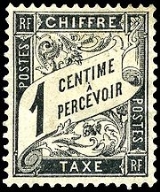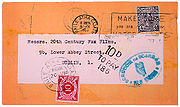
Postage due
Encyclopedia


Background
While the problem of what to do about letters not paying the full correct fee had existed since the creation of regular postal systems, it was greatly heightened by the advent of postage stamps, since customers were now making their own decisions about the right amount to pay, without the assistance of a presumably-knowledgeable postal clerk.While at various times some countries have simply adopted the expedient of returning the letter to the sender, many others have taken the approach of delivering the letter and collecting the fee from the recipient. Initially the process was handled by a clerk writing something like "Due 3 cents" on the cover, but this was subject to abuse by mail carrier
Mail carrier
A mail carrier, mailman, postal carrier, postman, postwoman , postman/postwoman , letter carrier or postie is an employee of the post office or postal service, who delivers mail and parcel post to residences and businesses...
s, who might write it on themselves and pocket the difference.
When the Universal Postal Union was founded in 1874 the problem with underpaid foreign mail was dealt with. The U.P.U. arrived at the decision that mail with insufficient postage should be marked with a "T" and from April 1, 1879 the amount missing would also be indicated in black. Later more countries started to use handstamps to indicate the amount due. Later the combination of handstamps with both the "T" and the amount missing came into use. From October 1, 1907 the rules were changed. The amount due would be charged instead of the amount missing would be indicated. The amount charged was usually double the amount that was missing.
First stamps
The problem was solved by France in 1859, with the issuance of official postage due stamps, affixed at the delivery office before being taken out to the recipients. Many other countries followed suit. (Occasionally, regular postage stamps have been used to fulfill a postage due function.)Postage due stamps (or "labels", to clarify that they have no value of their own) are not always affixed to individual letters; in the case of business mail, the total due might be summed, and the appropriate stamps added to the top letter in a bundle, or to a bundle's wrapper. The labels have also been used to collect money for other purposes, such as magazine subscriptions.
Since postage due stamps are almost always used only within a single country, they are usually quite simple in design, mostly consisting of a large numeral, and an inscription saying "postage due", "porto", etc.; often there is no country name. As with definitive stamp
Definitive stamp
A definitive stamp is a postage stamp, that is part of a regular issue of a country's stamps available for sale by the postal service for an extended period of time...
s, a variety of values are needed to make up specific amounts.
Collecting
While, technically, there is no reason for postage dues to reach private hands unused, postal administrations have sold them to collectorsStamp collecting
Stamp collecting is the collecting of postage stamps and related objects. It is one of the world's most popular hobbies, with the number of collectors in the United States alone estimated to be over 20 million.- Collecting :...
, and the postage dues of many countries exist in large numbers, often unused and of low value. Conversely, surviving examples of valid postally used postage due stamps tied together by a dated cancellation or other postal markings with a postage stamp
Postage stamp
A postage stamp is a small piece of paper that is purchased and displayed on an item of mail as evidence of payment of postage. Typically, stamps are made from special paper, with a national designation and denomination on the face, and a gum adhesive on the reverse side...
on cover are less common and are sought after by a philatelists.

